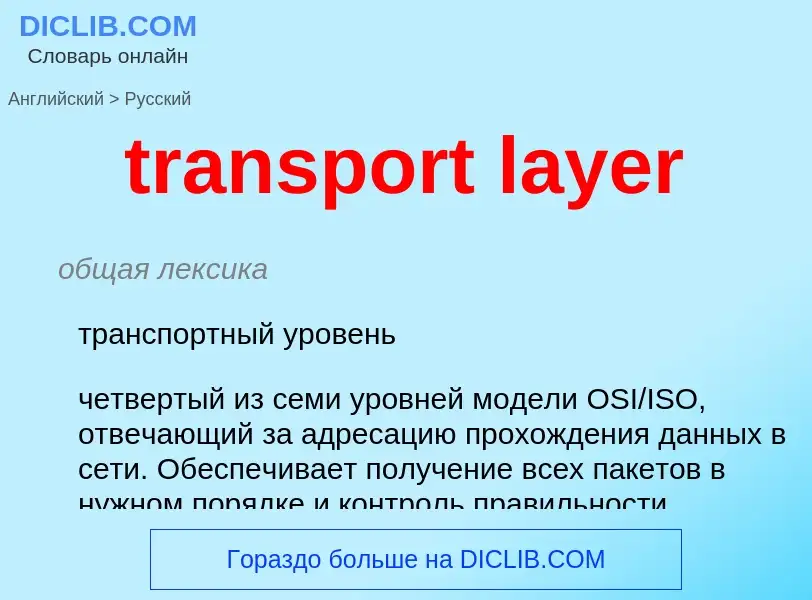Translation and analysis of words by ChatGPT artificial intelligence
On this page you can get a detailed analysis of a word or phrase, produced by the best artificial intelligence technology to date:
- how the word is used
- frequency of use
- it is used more often in oral or written speech
- word translation options
- usage examples (several phrases with translation)
- etymology
transport layer - translation to English
общая лексика
транспортный уровень
четвертый из семи уровней модели OSI/ISO, отвечающий за адресацию прохождения данных в сети. Обеспечивает получение всех пакетов в нужном порядке и контроль правильности. Предоставляет услуги по обеспечению передачи данных между сетевыми устройствами. Во время сеанса обе системы сами поддерживают передачу данных, так как между ними устанавливается виртуальная связь, аналогичная гарантированной телефонной коммутации
Смотрите также
общая лексика
транспортный протокол, протокол транспортного уровня
сетевой протокол, выполняющий функции транспортного уровня модели OSI
Смотрите также
общая лексика
сетевой уровень
третий снизу из семи уровней в эталонной модели OSI. Реализует функции маршрутизации пакетов, обработки ошибок, мультиплексирования пакетов и управления потоками данных. Если пакет адресуется рабочей станции в той же ЛВС, то он пересылается непосредственно, если он должен быть передан другой сети, то пакет пересылается на маршрутизирующее устройство. Самые известные протоколы этого уровня: IPX (в сетях NetWare), IP (в сетях TCP/IP) и X.25 (в сетях с коммутацией пакетов)
Definition
Процесс действия по знач. глаг.: закольцовывать.
Wikipedia

In computer networking, the transport layer is a conceptual division of methods in the layered architecture of protocols in the network stack in the Internet protocol suite and the OSI model. The protocols of this layer provide end-to-end communication services for applications.: §1.1.3 It provides services such as connection-oriented communication, reliability, flow control, and multiplexing.
The details of implementation and semantics of the transport layer of the Internet protocol suite, which is the foundation of the Internet, and the OSI model of general networking are different. The protocols in use today in this layer for the Internet all originated in the development of TCP/IP. In the OSI model the transport layer is often referred to as Layer 4, or L4, while numbered layers are not used in TCP/IP.
The best-known transport protocol of the Internet protocol suite is the Transmission Control Protocol (TCP). It is used for connection-oriented transmissions, whereas the connectionless User Datagram Protocol (UDP) is used for simpler messaging transmissions. TCP is the more complex protocol, due to its stateful design incorporating reliable transmission and data stream services. Together, TCP and UDP comprise essentially all traffic on the Internet and are the only protocols implemented in every major operating system. Additional transport layer protocols that have been defined and implemented include the Datagram Congestion Control Protocol (DCCP) and the Stream Control Transmission Protocol (SCTP).


